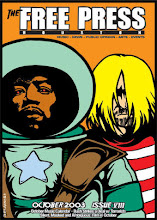The Baader Meinhof Complex

If you're a student of history, of the events of the 1960s in particular, you'll find grains of truth on The Baader Meinhof Complex (Der Baader Meinhof Komplex). Now as then domestic terrorism is an issue on the front page. TBMC reveals everything from how to bond in Middle Eastern training camps to the sad reality that each cell of a terrorist sect is one step away from the previous leader's ideology.
The film, directed by Uli Edel the director oddly enough of a kid's vampire film from 2000 The Little Vampire, wavers from Battle of Algiers military precision type seriousness to exploitative and gratuitous American International drive-in fashion and design. In other words this is a film you want to see twice. Newsreel and vintage footage mixes with the dramatic narrative. Bombings, gunfights, riots and general mayhem unfolds while a core group of radical thinkers comes of age. Issues of Germany's earlier political behavior (WWII) are spurned by the younger generation only their methods lead to criminal lifestyles. There's some serious ideas bandied about during TBMC and said ideas are tossed like a salad with salacious images of femme revolutionaries who walk the walk. Films like TMBC come around once a decade; films that deal with revolution from within like Patty Hearst (1988) or Claude Chabrol's 1974 The Nada Gang. The protags here are not heroes and not exactly anti-heroes. Characters from both sides of the conflict are shown making good and bad choices, thus the sympathetic official played by Bruno Ganz tries to understand them as well as apprehend.
The Baader Meinhof Complex takes place in a universe where the world view is actually a world view, not a xenophobic take on historical events. The 60s include riots in France, revolution in Czechoslovakia, hundreds of students dead in Mexico (echoes of Tiananmen Square). Bright colors and shots of hot chicks in mini skirts and boots kidnapping and executing justice as seen in an era before animal rights and environmental activists give way to somber blues and harshly lit prison cells as the movie progresses. The soundtrack mixes scored music with rock of the era.
There's a lot of objectivity on display in TBMG. This is a film that has the gonads of a Scorsese gangster film like Casino or Goodfellows, only it's showing at one theater (Angelika downtown) and has no awareness. Do people who wear Che tee shirts even register names like Ulrike Meinhof and Andreas Baader. The actors portraying them are instantly smart. sexy and in a constant state of rebellion. That's the way TBMC plays. It's the kind of film that makes you want to learn more about the period or at least see a few more of the three or four lead actor's other films.









